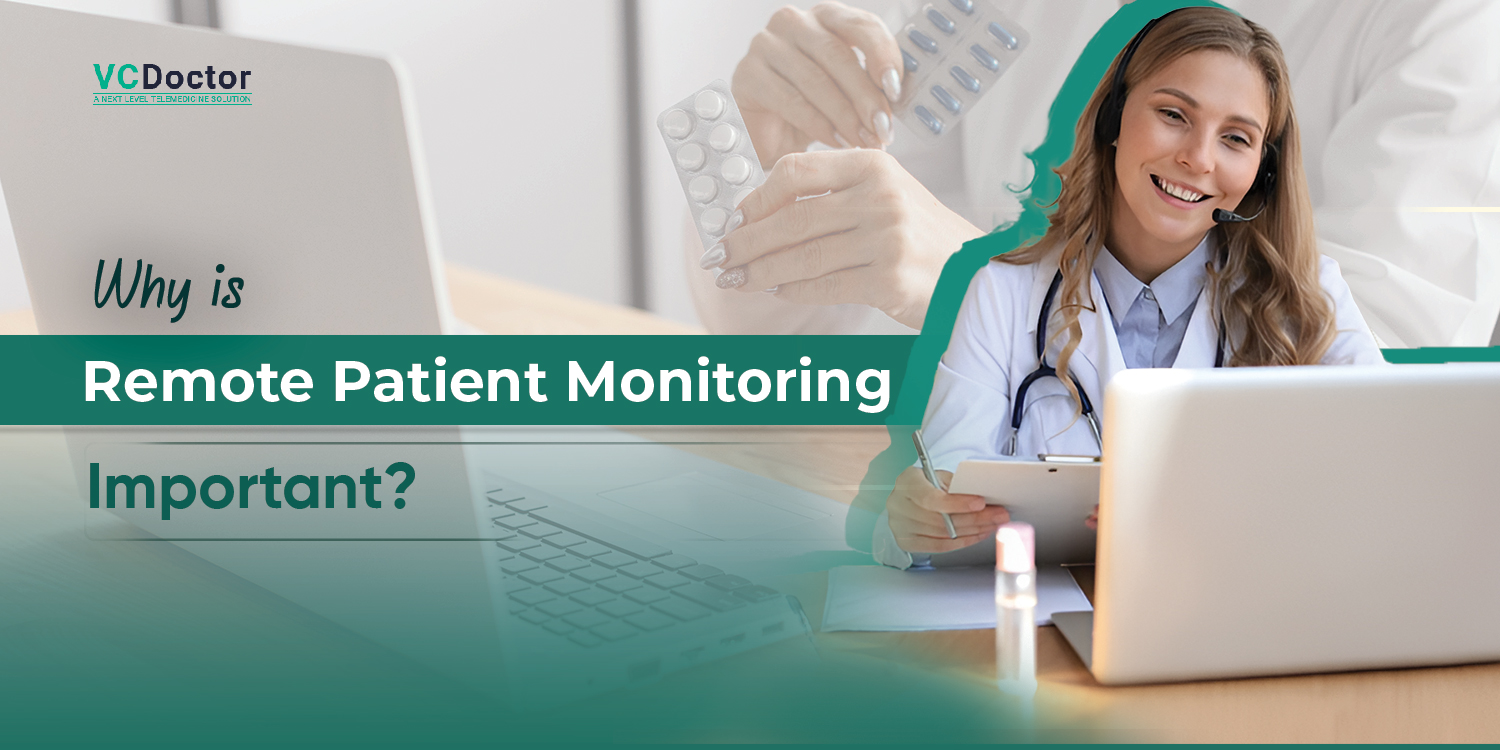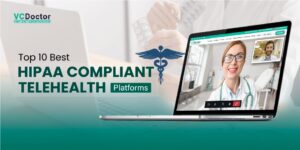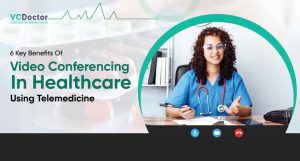Why is Remote Patient Monitoring Important?
In a complex medical environment, it takes a lot of work to manage the daily routine of check-ups and to communicate easily with doctors. Therefore, doctors are switching to a remote patient monitoring system, which makes it convenient for the patients and doctors to connect and diagnose the issue. It makes it easier to obtain health information from patients at home by using software and devices that are easy to use. There are several benefits to this strategy for both patients and healthcare professionals. Patients are less likely to be exposed to sickness in clinical settings and have fewer in-person visits, which lessens their burden.
VCDoctor is a top platform that provides a perfect telemedicine solution for patients and doctors to communicate and manage their diagnoses and medication. Furthermore, they may take an active role in controlling their health thanks to real-time data. RPM gives healthcare professionals the capacity to remotely monitor a more significant number of patients, allowing for the early detection of any health issues. This makes it easier to implement interventions on time, which may enhance patient outcomes, lower readmission rates, and better allocate healthcare resources. RPM, taken as a whole, is a major development in the management of chronic diseases, leading to a more effective and efficient system of healthcare delivery.
Table of Contents
- What is Remote Patient Monitoring (RPM) System?
- Who Qualifies for Remote Patient Monitoring?
- Is Remote Patient Monitoring Important?
- What Are the Benefits of Remote Patient Monitoring?
- Why is it important to be aware of Telemedicine?
- Conclusion
What is Remote Patient Monitoring (RPM) System?
What Are the Remote Patient Monitoring Devices?
Remote treatments rely on some devices which collect precise PHI. This is enabled through monitoring devices like:
- Glucose meter for diabetes management
- Heart rate monitor for administering congestive heart failure.
- BP cuffs for analyzing Blood Pressure levels.
- Oximeter for detecting the blood oxygen levels
- Continuous dementia surveillance monitors
- Calorie logging programs
- Exercise logging programs
- Musculoskeletal risk stratification software
- Grip strength sensors to manage Parkinson’s disease, etc.
Who Qualifies for Remote Patient Monitoring?
There are no such plans or qualification criteria for getting the RPM services. Any patient can seek remote patient monitoring. It depends upon some of the conditions like –
- Internet connectivity in the area
- Disease type (acute or chronic)
- Acute or with less problematic conditions can get RPM
- Physician’s interest in treatment, etc.
Generally, remote patient monitoring work is offered to patients like COVID-19 positive, patients with acute medical conditions, people from far-flung areas, etc. People who are diagnosed with severe medical conditions asked to immediately seek a physician are not allowed to avail RPM.
Is Remote Patient Monitoring Important?
RPM Software picks the patient health information (PHI) and gives doctors at their fingertips. The data is available 24*7 to the physician and patient. Simultaneously, it enables healthcare providers to offer high-quality treatment and diagnosis services.
Many people who seek RPM want to be acquainted with its importance and why it is popular. The few pointers below will describe the significance of Remote Patient Monitoring (RPM).
1. Access to Care
Many people find it troublesome for getting a doctor’s appointment. It needs a full day sometimes and an off from work. Remote patient monitoring allows one to get an appointment instantly within a few taps. It offers patients the freedom to get medical assistance at any time. Moreover, the physician enjoys the freedom to treat any patient in their spare time.
2. Quality of Care
It is always understood the work done in a free mental state brings more productivity than in a puzzled mind. Hence, the approach comes for the doctors when treating multiple patients at a time. RPM software allows any physician to check PHI at any time. This brings more focus on the medical aspect and brings 100% satisfactory medications.
3. Patient’s Engagement
RPM only gives its sustainability when utilized by the patient. For self-monitoring and check on an individual’s health, it is rudimentary that the patient acknowledges the software. Sometimes, checking on some other patient’s health dealing with the same disease can let others get involved.
4. Patient Education
Patient’s education on any point of health is the crucial term for them to understand. Either it is a severe medical state or a normal one, information about the diagnosis, cure, treatment, and after-treatment precautions is necessary. Simultaneously, it gives more engagement towards the software.
What Are the Benefits of Remote Patient Monitoring?
Any software in the healthcare industry gives numerous benefits if implemented correctly. By implementations, we mean both physicians and patients can access the RPM System more precisely. After using it for a while, both of the sides start generating a few benefits like:
- ICCM (Improved Chronic Condition Management)
- Cope-up with Readmissions
- Boosting Revenues
- Very Economic
- Smooth Working
- 24*7 Support
1. ICCM (Improved Chronic Condition Management)
Chronic conditions are something where the patient seeks instant medical assistance. Such conditions in the US account for around 90% of healthcare costs. Remote patient monitoring gives an analysis of the medical state that eventually pings the physician to talk about the future medical synopsis.
2. Cope-Up With Readmissions
The very big outcome that has been addressed with RPM solutions is “Reduced Re-admissions”. The big block in the success was the patient’s re-admissions. This has been decreased like anything because the software is designed to give a 360 Degree approach to patient’s health. The patient can also get an account of their routine health statistics like BP, Sugar, and other conditions.
3. Boosting Revenues
It enhances the revenue stream of doctors due to the 99457 and 99458 CPT codes. This gives reimbursement facilities for time spent on working like remote care involving reviewing patient’s health. The data are stored and collected on a very large scale and deliberate actions lead to earning revenue.
4. Very Economic
From the patient’s side, consultation fees, traveling allowances, normal check-ups, and test fees, etc. are completely saved. Now users can directly approach the doctor, get access to the medical state directly, and can invest the saved money on the respective health disorders. This brings flexibility to healthcare operations. People who are not financially stable can also get the best treatments from the Remote Patient Monitoring (RPM) Tool.
5. Smooth Working
It gives both doctors and patient’s a nap to administered the health properly. Doctors being able to access the PHI anytime can better focus on the cure. Simultaneously, the patient is at home, work, or any other place can get treatment and rest assured for the money or related expense as well.
This encourages more patient engagement, smooth workflows for the physicians, and more transparency between the two i.e. Patient & Doctors. Moreover, if a patient is required to give a visit to the hospital then he/she is requested to do so in their free time.
6. 24*7 Support
When patients are guided on how to utilize the device, they can rest assured that someone is always willing to give technical support. It brings reliability towards the physician or team and towards the software itself. Hence, for any patient who is seeking help on accessing any section of the software or needs some help, the software allows them to do so easily.
Why is it important to be aware of Telemedicine?
A major segment that comes along with the term RPM is Telemedicine. Remote patient monitoring is a subsidiary unit of Telemedicine Platform. The best platform offering Telemedicine with HIPAA Compliance is VCDoctor. This facility since the previous year has become a pivotal need. Why? Let us understand through these pointers:
1. Protection to Physician & Patients
Telemedicine is a platform that delivers remote patient healthcare. In the course of Curfews and Lockdown due to the COVID-19 pandemic, it becomes to stay secure. Telemedicine allows remote healthcare that eventually saves both doctors and patients to get in contact. This reduces life threats from infections, pandemics, etc.
2. Radiologist can Read From Anywhere through Remote Patient Monitoring
The healthcare sector not only in the Radiology department but in other units too has seen the working due to COVID-19. It has changed the thing totally that impacted the working of Radiologists. Now, these radiologists are offered work-from-home by taking their technologies with them. One more addition to their technical aspect becomes Telemedicine. This has enabled them to access or read the reports from any corner of the world.
3. Offers Vacant Beds & Services Using Remote Patient Monitoring Software
Patients being treated via Telemedicine Platform gives an additional kick to the hospitals in serving vacant beds to the deserving patients. Simultaneously, in the light of this infectious disease when ventilators, ICUs are full of patients, Medical services are being distributed evenly to the deserving patients.
Planning to develop a customized RPM app for your Company
Conclusion
Remote patient monitoring systems can benefit both medical facilities and patients simultaneously by enabling them to navigate issues and provide proper medication within the time frame. VCDoctor is the leading platform that provides a quick mode of communication between doctors and patients where they can talk about the current situation and get accurate medication to solve the problem. Understand the complete process and workings of remote patient monitoring systems and how they enhance the experience of users in the healthcare industry.
Moreover, if you want to get a custom healthcare app that involves a remote person monitoring system and components like cloud storage, then visit the top professional in the healthcare It industry.
FAQs
1. How does RPM empower patients?
RPM promotes patient participation by enabling at-home self-monitoring of vital signs and health data. It increases their understanding of self-awareness and gives them the ability to manage their ailments more actively. Additionally, it offers patients more control over their treatment and welfare. RPM can also lower the healthcare expenses and the travel strain incurred by routine in-person appointments.
2. What impact does RPM have on healthcare outcomes?
Through the provision of ongoing health data in between doctor appointments, remote health monitoring enables early identification of any health issues. This gives medical professionals the ability to step in quickly and modify treatment plans as necessary, which may help to avoid problems and enhance overall patient results.
3. How does RPM benefit healthcare providers?
More comprehensive information on a patient’s health trajectory may be gleaned via RPM than from office visits alone. It enables medical personnel to recognize patients who are more likely to experience issues. It prioritizes the treatment of patients and takes necessary steps to avoid delay. It automatically leads to improved patient care and a decrease in hospital readmission rates.
4. Is patient data security ensured with RPM?
In RPM, data security is crucial. Reputable RPM systems often utilize secure transfer techniques and robust data encryption to safeguard patient information. It is crucial to employ an RPM system that conforms to strict HIPAA regulations in order to safeguard patient privacy.
5. What chronic conditions can benefit from RPM?
Numerous chronic illnesses, including diabetes, asthma, heart disease, and chronic obstructive pulmonary disease (COPD), are well managed with RPM. It also works as a home health monitoring system for patients recovering at home from acute diseases and for post-surgical monitoring.





Remote patient monitoring is one of the best part of telemedicine/telehealth solutions, and it provides a facility to monitor patients who need emergency care or primary care. This post contains dept information. Thanks for sharing such kind of post.